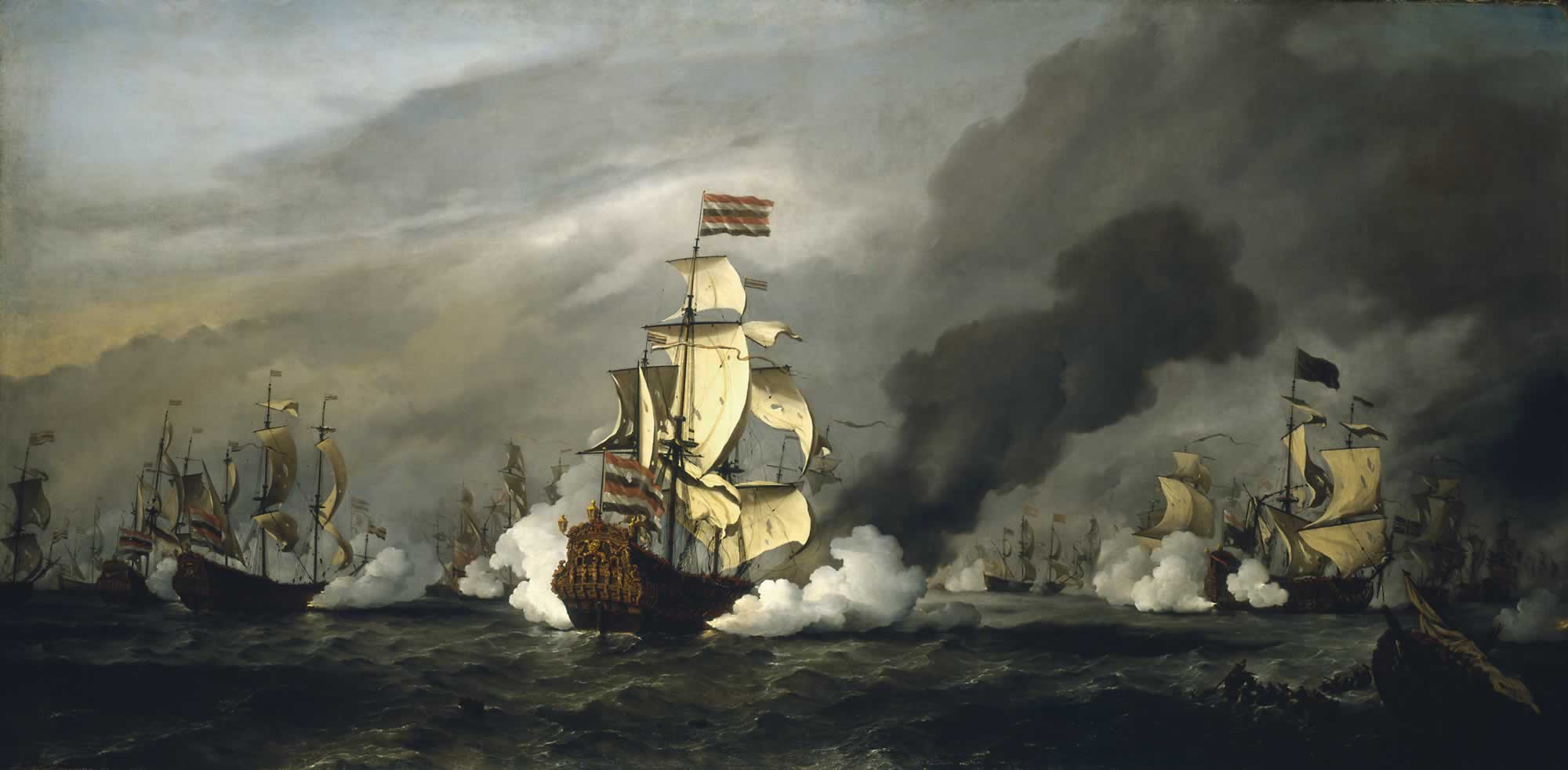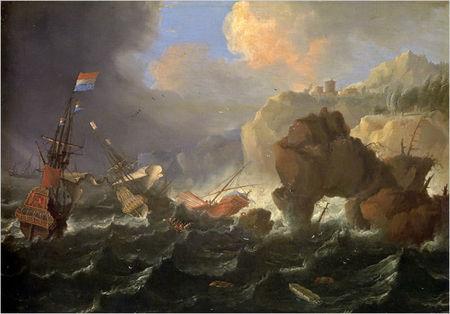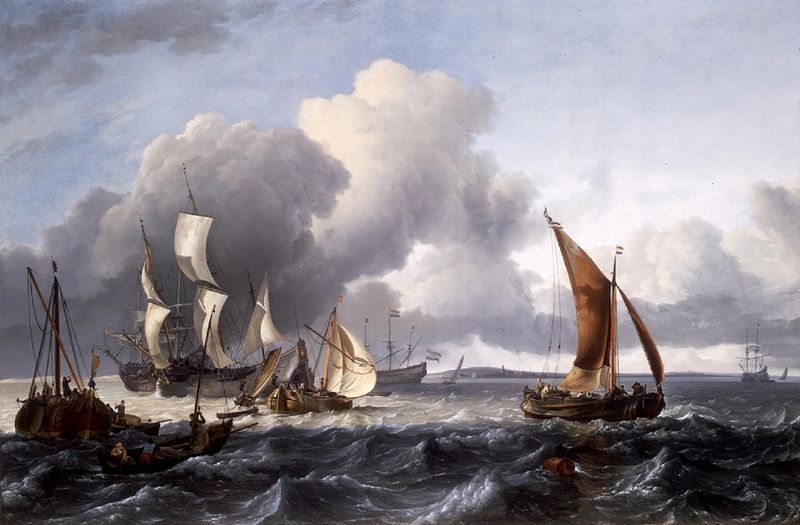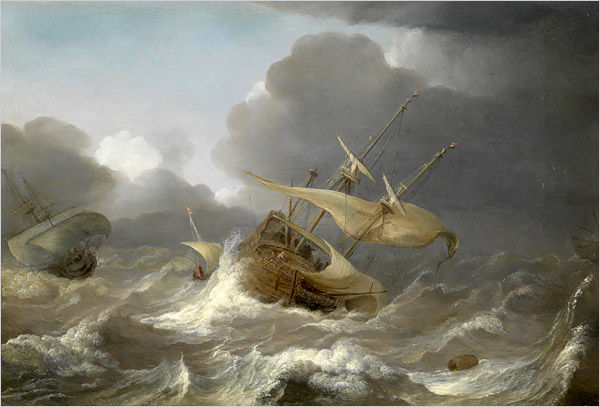In 2009 the Peabody Essex Museum presented The Golden Age of Dutch Seascapes, 70 works by Dutch masters of maritime art working in the time of Rembrandt and Vermeer. Painted during the peak years of Dutch artistic achievement between 1600 and 1700, these superlative, emotional works are the first in which European artists realistically depicted natural settings, rendering coastal atmospheres with great focus and virtuosic technique. Artists such as Jacob van Ruisdael, Jan Porcellis, Simon de Vlieger and Ludolf Backhuysen were masters of air, light and water, and used their prodigious talent to convey a world of political allegory and mystical allusion on canvas.
Nothing matches the sea as a subject for its versatility, its many moods, and the endlessly intriguing optical effects of water and light. Dutch masters of paint and color attracted to the seascape developed novel approaches to composition and technique. The methods pioneered by the artists in this exhibition traveled well, spreading from the Netherlands to England, the rest of Europe, and ultimately to the Americas, serving as the foundation for the many examples of maritime paintings in the collection of the Peabody Essex Museum. Fittingly, the Museum was the only U.S. venue for this exhibition, originating from the National Maritime Museum, Greenwich, UK.
The Sea – A New Subject
With works celebrating Dutch trade and commemorating military victories, the seascape became a popular genre serving the tastes of a prosperous Dutch Republic. Aristocratic patrons and wealthy burghers commissioned works intended for intimate viewing and public display.
A Sea of Symbols
The sea and the vessels traversing it bore rich meaning for Flemish and Dutch artists, who voraciously mined the visual vocabulary offered by maritime subjects. A ship could represent the progress of an individual soul or the unified destiny of a nation with equal impact. Storms and shipwrecks supplied ample drama in the form of obvious danger from greater powers, as in
Seascape with Sailors Sheltering from a Rainstorm by Bonaventura Peeters the Elder,
while half-hidden rocks and submerged sea creatures suggested mystery, uncertainty or the realm of the supernatural. Military assertions and ecclesiastical refuge took geological forms that clearly communicated the artist’s position — or that of his patron — on Dutch political or spiritual life.
Vistas of the Netherlands
As the Dutch emerged as a world military and economic presence, they projected an increasingly consistent image of their country and lifestyle through their art. Luminous streams of sunlight amid atmospheric clouds characterize a typical lowland sky. Coastal cities as depicted by Abraham Storck were recognizable to 17th-century inhabitants and represented the general nature of Dutch life at the time, rather than resorting to biblical allusions or historical conventions.
Far Horizons
National exploration and expansion enlivened Dutch painting, fueling a particular desire for Scandinavian and Mediterranean scenes. Commercial relationships ultimately altered Dutch taste and imagination with fir trees and glaciers from the North, and idealized monuments and ruins from the South. Art aficionados would be familiar with such Italian settings, and the very sight of them evoked pleasure, elegance and exoticism. The sun-suffused A Spanish Three-Decker at Anchor off Naples by Abraham Willaerts breezily captures Mediterranean light and atmosphere and would have deftly transported Dutch viewers abroad.
Patronage, Battles and the Exotic
The inspiration of military might in Golden Age painting cannot be overstated. Netherlandish forces were unabashed in their celebration of naval victories and heroes. Pictures such as A Dutch Settlement in India, Probably Surat by Ludolf Backhuysen were commissioned by Dutch provincial potentates, cities or by the admirals themselves. Artists often accompanied the fleet to commemorate battles, at times compressing various episodes of a naval event into a single scene, bringing all of the pictorial power of war and seascape to bear. The interplay of gun smoke, fire and water tested the limits of artistic technique and infused every painting with potency and true bravado.
From an excellent review: (images added)
In many of these we see the Dutch taking pride at the boldness of seafaring men:
Andries van Eertvelt's moonlit "Embarkation of Spanish Troops" (1630s) bustles with swashbuckling activity and operatic lighting...At the other end of the spectrum, works such as
Porcellis's "Dutch Ships in a Gale" capture the fragility of all that oak, hemp and canvas—here the wind-lashed sails of a foundering merchant vessel look like shredded silk. The symbolism of the sea and of shipwrecks is explored in fascinating detail. On one hand, we can read such works as the anonymous
"Wreck of the Amsterdam"
and Jan Blanckerhoff's "Shipwreck Off a Rocky Coast" (c. 1660) as allegories warning of disaster when the "ship of state" is manned by a shipload of fools..There is also a vivid dialectic between the representation of North Sea light and the miracle of Mediterranean light that many of these artists discovered when they went to Italy. The ravishing sunset of
Hendrik van Minderhout's "Italianate Harbour Scene" (1670) echoes the gilded luminescence of Claude Lorrain's Italian seaports, while the yellows, pinks and veiled quality of
Pieter van den Velde's "Ships at Anchor Off a Mediterranean Harbor" (1680s)
strikingly anticipate Turner's magical hand.
In works such as
Eertvelt's "Dutch Ships Sailing Off a Rocky Shore" (1610-15),
the scrupulous depiction of multitudinous figures clambering about the decks and rigging—each face painted with an individuality of expression—conveys not only the relative insignificance of these crews and vessels against the challenging forces of nature, but also the sheer number of able seamen needed to sail these doughty ships..Then there are those magnificent "sea fights," in which the actions depicted often depended on what the Dutch or English patron wished to memorialize. Painted around 1670,
Storck's "The Royal Prince and Other Vessels at the Four Days' Battle, 1-4 June 1666"
records the only genuine Dutch victory during the Second Anglo-Dutch War and boasts a wonderful visual rhythm of masts and sails against a counterpoint of clouds and waves. Likewise, the elder
Van de Velde's "Battle of Scheveningen" (1655),
From another excellent review (images added)based on his own eyewitness sketches, combines action that occurred at different times into one virtuoso scene of Dutch triumph.
This well-produced show presents 72 paintings by about three dozen of the genre’s most esteemed practitioners. It was organized by the National Maritime Museum, in Greenwich, England, where it appeared under the title “Turmoil and Tranquillity: The Sea Through the Eyes of Dutch and Flemish Masters, 1550-1700.”
Nautical history buffs will be in heaven. Many paintings document — or, more accurately, recreate and commemorate — major events in maritime warfare. Some of these are spectacular. Painted in 1687,
Willem van de Velde the Younger’s “Gouden Leeuw at the Battle of the Texel, 21 August 1673” shows nearly a dozen battleships deployed across a 10-foot-wide canvas. Viewed from the rear with sunlight brightening its full set of sails, the majestic Gouden Leeuw (Golden Lion) has cannon smoke billowing from both sides. Black haze fills the canvas’s right side, and other ships engage one other in the murky distance. Usually made on commission, pictures of this sort represented victories at sea. They were a form of patriotic propaganda...
More images from the exhibition:
The catalog entry for Jan Peeters’s “Ships and a Galley Wrecked on a Rocky Coast,” a turbulent scene that includes a fortress on a distant cliff, notes, “The castle, strong, fortified and built high up on the rocks, represents protection, as well as the belief and hope placed in God.”
"The Darsena delle Galere and Castello Nuovo at Naples," 1703, by Caspar van Wittel. Photo: National Maritime Museum, Greenwich, United Kingdom
"A Dutch Ferry Boat before a Breeze," late 1640s, by Simon De Vlieger, Photo: National Maritime Museum, Greenwich, United Kingdom
"Fishermen on Shore Hauling in their Nets," circa 1640, Julius Porcellis. Photo: National Maritime Museum, Greenwich, United Kingdom
"The Port of Genoa," circa 1660, by Adriaen Van Der Cabel. Photo: National Maritime Museum, Greenwich, United Kingdom
"Mediterranean Harbour Scene with the Saint Jean Cathedral at Lyons," 1660, by Jan Abrahamsz Beerstraten. Photo: National Maritime Museum, Greenwich, United Kingdom
Jan Peeters, 'Ships and a Gallery Wrecked on a Rocky Coast'. Photo: Courtesy Peabody Essex Museum
Jan van de Cappelle, 'A Calm Sea with a Jetty and Ships'. Photo: Courtesy Peabody Essex Museum
A Spanish Three-Decker at Anchor off Naples, 1669, Abraham Willaerts. Oil on canvas, 865 x 545mm © National Maritime Museum
Italianate Harbour Scene with the Monument of Ferdinand de’ Medici at Leghorn, 1670, Hendrik van Minderhout. Oil on canvas, 1475 x 2615mm © National Maritime Museum
The Merchant Shipping Anchorage off Texel Island with Oude Schild in the Distance, 1665. Ludolf Backhuysen. Oil on canvas. 1065 x 1650mm. Provenance: Caird Collection, 1937, BHCO916 (p.74) © National Maritime Museum
"Dutch Ships in a Gale," circa 1620 by Jan Porcellis. Photo: National Maritime Museum, Greenwich, United Kingdom
The Wreck of the Amsterdam, c.1630. Anonymous. Oil on canvas, 1257 x 1778mm. Provenance: Palmer Collection, BHCO724 (p.70) © National Maritime Museum,
Seascape with Sailors Sheltering from a Rainstorm, c. 1640 © National Maritime Museum,

.jpg/800px-Andries_van_Eertvelt_-_Embarkation_of_Spanish_Troops_(1630s).jpg)






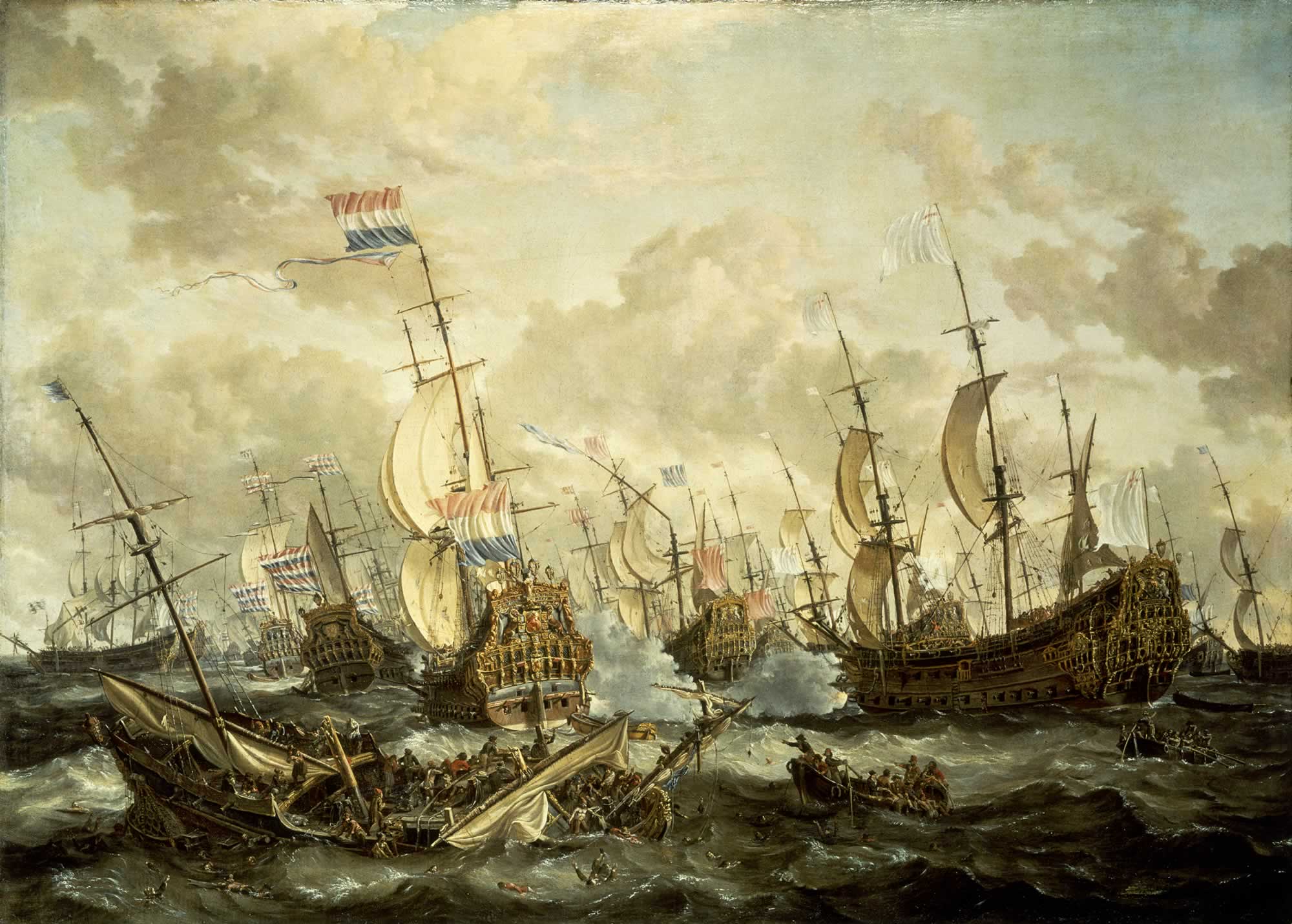
.jpg/800px-De_slag_bij_Terheide_-_The_Battle_of_Schevening_-_August_10_1653_(Willem_van_de_Velde_I,_1657).jpg)
